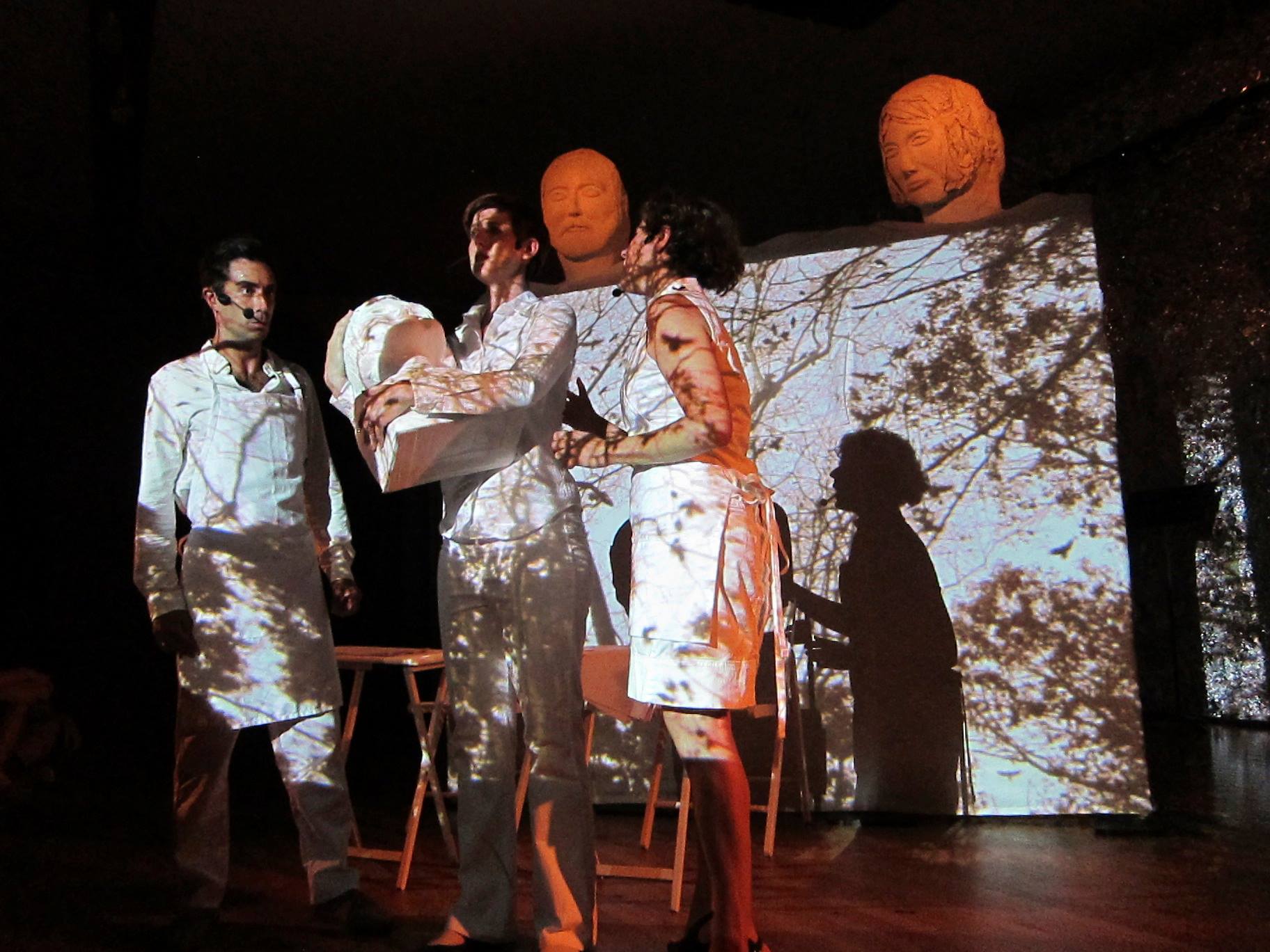Settling into David Smooke‘s nonopera, “Criminal Element“, is akin to letting a book of Rorschach paintings fall open in front of you. As each of the five scenes unfolds, the pages of that book flip in the breeze. That is to say, a nonopera in an invented language can take on myriad meanings and plays out the perceptions of those watching and listening. Gazing around the sultry Area 405 in Baltimore on Saturday night, there could have been as many interpretations of Smooke’s work as there were people crowded into the performance space. Rhymes With Opera singers Elisabeth Halliday, Robert Maril, and Bonnie Lander with the SONAR new music ensemble quartet under George Lam‘s conducting excelled in the performance of this work creating numerous audience entry points to a work that could be intimidating to some. Rhymes With Opera also used the evening as a platform to share twelve one-minute “signature” operas written for the vocal trio by some favorite local composers. Each were compelling in their own way. Timothy Hansen’s “Pocket Watch”, Anna Meador’s “Nuclear Winter”, and Andrew Histand’s “Zany Colorful Schwa” were particularly humorous.

It was French trader, Jérôme Kerviel, and his fraud that became the underlying narrative for Smooke. Kerveil was charged with losing more than $7 billion in Société Générale assets by conducting a series of unauthorized and false trades between 2006 and 2008 which he was able to hide during that time because of his extensive knowledge of the computers and trading systems used by the company. His actions were one of the catalysts for the 2008 recession.
Although this piece creates theatrical scenes with some referential elements, it is a meditation on class differences and on the germinating factors in exorbitant criminal events, and is not intended to portray the life of any specific individual. – David Smooke
Though the Kerveil story is the general narrative structure, the work does transcend its references. Written in 2010, Rhymes With Opera originally performed “Criminal Element” in 2011. Now, in its fully staged version, they added a depth of visual artwork to accentuate the music. Working with ten-foot tall puppets, by designer and co-director Valeska Pupuloh, and video projections, designed by Meg Rorison, the effects allowed the audience to be guided through the story without forcing any specific narrative. The puppets, three large, dual-sided heads and hands, were manipulated well by the three puppeteers (David Brasington, Daniel Friedman, and Jessie Poole) particularly because they never overtook the performance space but added to the scale, depth, and theatricality of the performance. To this taste, certain props and the handling of puppet elements in front of the screen was a bit confusing at times but did not detract from the overall.
The benefit of using familiar language sounds but outside the context of recognizable language is mainly that the audience begins to focus on the physical language to understand the interactions between characters. However, it is interesting to note even in an invented language one can understand a cry of exasperation such as Elizabeth Halliday’s numerous utterances, “crumblit!” Halliday was tasked, as “the perpetrator”, with the continuity of rising drama and tension throughout the piece. She held the audience’s attention throughout with characteristic vocal power and physical stage presence. With so many visual and aural factors to take in, the singers never allowed the audience to forget that it was a vocal production. Soaring through their ranges, they stunned as soloists and displayed attentive ensemble singing. Lander showed off stratospheric coloratura especially during her sung cackle in the office scenes. The singers also took moments to create color shifts and change vocal styles. Maril and Lander crooned a duet from the back of the audience while accompanying themselves on ukulele and melodica. Halliday also played an angular autoharp accompaniment in the last scene.
The string players of the SONAR new music ensemble quartet are not only extremely talented musicians but it is also evident that they are a cohesive unit. During Scene II: The Seashore, the video projections changed to that of lapping water and the ensemble playing was beautifully evocative of that change. Descending glissandi in the violin writing melted into the “sh” /ʃ/ unvoiced consonants from Lander. The instrumentalists also impressed during an interlude which offered a stark melody and drone in the second violin and viola parts while the first violin and cello took off with wild double stops.
Rhymes With Opera has a devoted fan base in Baltimore and is expanding its reach along the East Coast. With imaginative and compelling works like this fully staged version of “Criminal Element” it is easy to understand why new music lovers keep returning and introducing their friends to the troupe. They are set to expand their season next year to include two operas: “Red Giant” and a hiking opera by Baltimore-based composer Erik Spangler. This is also the inaugural year of the RWO New Chamber Music Workshop with a concluding performance on August 10, 2013.

Reblogged this on The Glass and commented:
Megan Ihnen reviewed the Baltimore performance of the newly-staged verison of David Smooke’s Criminal Element
I especially liked the Rorschach metaphor
Thanks! I thought it was pretty apt to the overall experience. Wish you could have been there too.